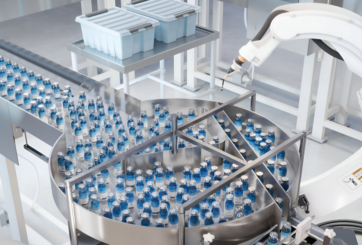The Role of Track and Trace in Pharma’s Industry 4.0
The issue of counterfeit medicines continues to be a huge issue of the pharmaceutical industry, with 10% of the world’s drug thought to be fake. Industry 4.0 provides an opportunity to overhaul current systems and create an efficient industry operating dynamic.

The issue of counterfeit medicines continues to be a huge issue of the pharmaceutical industry, with 10% of the world’s drug thought to be fake. Industry 4.0 provides an opportunity to overhaul current systems and create an efficient industry operating dynamic.
The pharmaceutical sector of 2022 was under more pressure than it has faced in living memory. In addition to the ongoing effects of Covid, increased regulation and spiraling business costs, the issue of fake medicines continues to cause serious concerns.
It is predicted that 10% of pharma products worldwide are counterfeit, with the global counterfeit drug market exceeding an eye-watering $75bn. Research further estimates that the death-toll caused as a result could increase to 10 million people by 2050. Estimates by the World Health Organization show that between 72,000 and 169,000 children may die from pneumonia every year after receiving counterfeit drugs, and that fake anti-malarial medication might be responsible for an additional 116,000 deaths.
Studies show about 9%-41% of medicines sold in low- and middle- income countries are counterfeit. In contrast, in high-income countries, such as the US, less than 1% of medicines sold are counterfeit.
It is fair to imagine that many pharmaceutical company bosses are currently preoccupied with how they can ensure their businesses remain competitive and can thrive in the coming years. Now, imagine if there were systems out there that can take away a lot of this headache. Step forward track and trace and plug and play, two concepts that pharmaceutical firms are increasingly turning to as a way of achieving operational efficiency and of keeping a lid on rising expenses.
How Track and Trace Can Achieve Pharmaceutical Operational Efficiency
More companies than ever are realizing for themselves the importance of track and trace solutions. Indeed, the global market is estimated to reach an expected value of $14.3bn by 2030, growing at a CAGR of 19.30% during the forecast period (2022–2030) according to forecasts by Straits Research.
The advent of Industry 4.0 – or the fourth industrial revolution, characterized by the introduction of hyper-connected technology – is presenting a golden opportunity to completely overhaul current, often antiquated systems. These are often preventing pharmaceutical businesses from performing at their optimum output level.
A combination of cyber-physical systems, the Internet of Things and the Internet of Systems will power Industry 4.0 and allow the smart factory to become a reality. As a result of the support of smart machines that keep getting smarter as they get access to more data, the global pharmaceutical sector will become more efficient, productive, and less wasteful.
This is where a watertight track and trace system will really shine. It links together the essential components that modern pharmaceutical businesses need to thrive. These components include operational shopfloor efficiency, greater warehouse automation, generating more data which will further optimize the supply chain, and creating customer engagement through product identification.
The Impact of Edge Computing on Warehouse Operations
Edge computing is a distributed IT architecture in which client data is processed at the periphery of the network, as close to the originating source as possible.
The impact of this new-edge technology on the pharmaceutical track-and-trace sector will be huge, especially where overall supply-chain operations are concerned. One of the main changes is that it will power automatic, time-sensitive supply chain processes in warehouses, factories, and manufacturing facilities. These processes will lessen the need for human management and create optimal outcomes while eliminating the risk of error due to manual processes.
One way that edge computing will drive the process will see the addition of a scanner with a mobile application supporting the handling of serialized products across the supply chain and within warehouse operations. It will run on commercially available devices deployed at the warehouse, packaging, and other operational facilities.
Furthermore, new-edge technology will sit behind the rise of smart robots that are poised to transform warehouse operations even further. Indeed, Gartner predicts that 75% of large enterprises will have adopted some form of smart robots in their warehouse operations by 2026 as they search for flexible automation.
The Rising Importance of Plug And Produce
Plug and produce is defined as “the capability of a production system to automatically identify a new or modified component and to integrate it correctly into the running production process without manual efforts and changes within the design or implementation of the remaining production system”.
In other words, plug and produce is rapidly rising to prominence as a method of automating production lines and reducing the overall time and effort needed to reconfigure a manufacturing system. A user can add and remove devices without having to do manual configuration, and without knowledge of computer hardware.
Certainly, to most pharmaceutical businesses, this will be irresistible because we still largely reconfigure production lines manually.
However, the ongoing Industry 4.0 revolution anticipates that these production lines will become semi-automatic and self-controlled. This will be made possible by utilizing the plug and produce concept in the production systems. This would then enable new deployments introduced to the existing production line, along with its reconfiguration, or extensions.
In other words, when a new machine, or a subsystem, is deployed or ordered, all its components can be brought to the production line mechanically, electrically, and informatically. This can be done in a semi-automatic manner, in such a way that the entire system starts to operate without any external help.
The benefits of this are endless. Not only will this approach support a much more agile, streamlined supply chain, it will benefit increased automation on the shop floor, which will help companies to keep costs down in the long run. It will lead to a much higher rate of compliance through a standard interface and will make it much more straightforward for firms to change suppliers, vendors, and customers.
A Word Of Warning
Track and trace, together with plug and produce technology, is becoming increasingly high on the agenda for multiple companies – and it is not hard to see why.
However, there is a slight warning-bell that I would like to sound.
I have long argued that the pharmaceutical sector needs to get far better at working together. This is especially true if this revolutionary technology is to become a mainstream sector success.
It will be essential to allow fast and accurate data to flow from the factory floor to multiple technology layers, without the need for top-down integration. But this can only come about through collaboration, by “competing” companies increasingly becoming more open and transparent to allow data to be used for the good of the entire sector at large.
Tighter collaboration will allow track and trace, and plug and play, to really shine – and the industry has a duty to ensure we allow this to happen.
Click here to view the original article in In Vivo Pharma Intelligence



